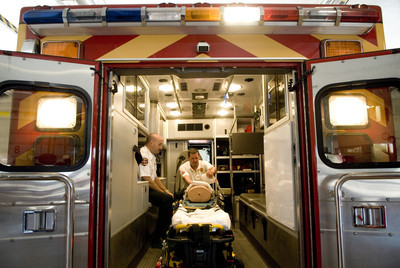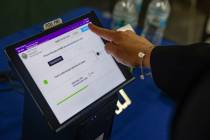Rescuers show safety techniques
A sharp turn, a jostle and a life-or-death time crunch can mean a lot to emergency medical technicians and paramedics helping patients inside an ambulance.
The conditions inside the vehicle and the possibility of an outside collision make saving lives even more high risk. Between 1988 and 1997, 23,000 ambulance workers were injured and 350 were killed in ground accidents nationwide.
Most of the emergency medical services-related accidents occur during "Code 3" driving, or with lights flashing and sirens blaring.
"There is this false sense of security that people are going to get out of the way," said Las Vegas Fire Department EMS Medical Director Tim Slattery during a demonstration at headquarters Friday.
The demonstration helped launch the National Fire/EMS Safety, Health and Survival Week for June 22-28.
It's an opportunity for officials to highlight the new technologies and strategies being explored to improve EMS safety during patient transportation.
Fire Department EMS coordinator Tim Orenic said he has received several minor injuries as a result of being tossed around inside ambulances.
His balance was tested several times Friday during an in-motion demonstration, in which he was jostled forward across the gurney and back into a seated position.
"There's not much you can do to anticipate it," Orenic said. "Sometimes the driver can help us predict, but others, you just get launched."
Aside from driver assistance, safety measures, such as grab rails, extra padding on seats and sharp edges, and the placement of medications and equipment within easy reach, ease the ride for EMS technicians.
Las Vegas rescue vehicles also have AutoPulse, a battery-operated chest compression device that relieves some need for technicians to stand over a victim while performing CPR.
The device is just one of the technologies being explored to keep technicians seated, restrained and clear from falling inside the ambulance. Slattery said other measures such as evaluating when Code 3 driving is absolutely necessary is another strategy to keep technicians safe.
Seventy-four percent of EMS fatalities occur during transportation incidents such as T-bone strikes to the vehicle.
"We want to look at why and what kinds of calls they would need to go Code 3 for -- obviously immediate life and limb issues," he said. "But maybe they don't need the sirens and lights and be just as efficient. We are looking at the time equation."
Contact reporter Maggie Lillis at mlillis@reviewjournal.com or 702-383-0279.




























